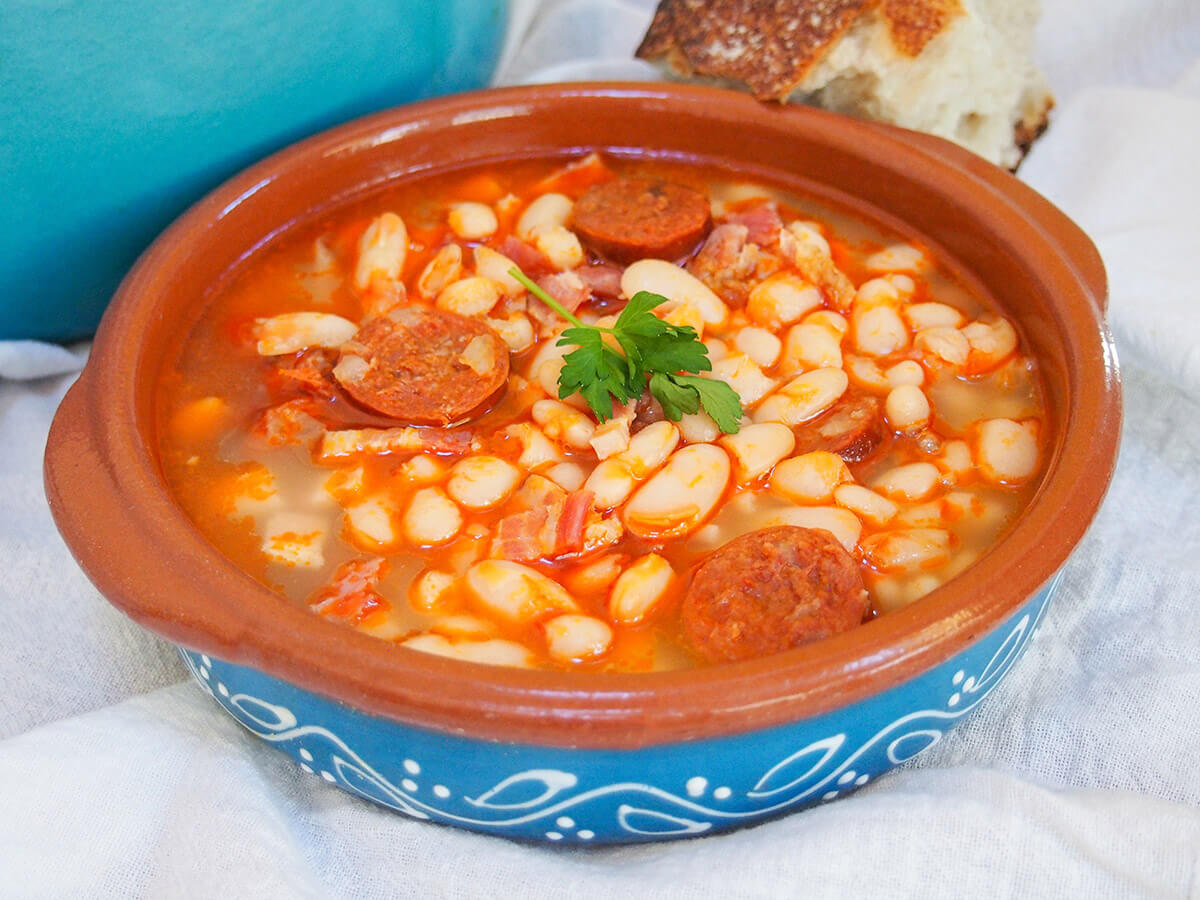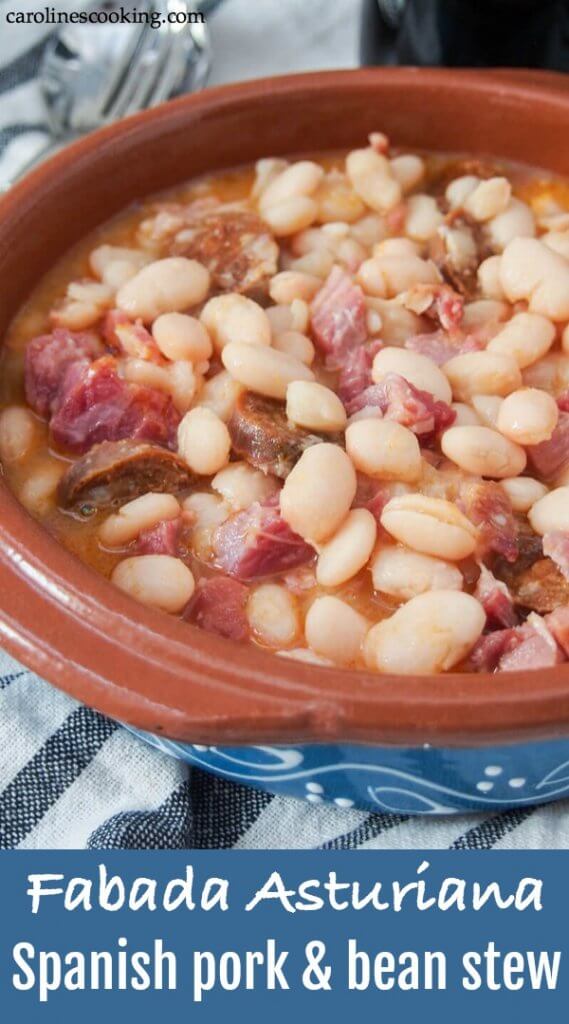You may well have heard of cassoulet - well fabada Asturiana is it's Northern Spanish cousin. A hearty, warming white bean stew with lots of porky goodness, it's incredibly easy and perfect for a cold day.

This post may contain affiliate links, where we earn from qualifying purchases. See more details in the policy page.
I have a confession: I've been sitting on this recipe for some time. Somehow I didn't get round to sharing this fabada recipe last winter and as you'll see, it really is a cold weather dish.
In fact it came about when we were stuck inside for a few days. The week between Christmas and New Year just over a year ago coincided with some really cold weather. Accompanied by new toys, none of us were really up for going anywhere, so I also did some full on comfort food cooking.

We did pretty well those few days, with things like braised lamb shanks and avgolomeno soup that I shared soon after. We also had some old favorites like romesco de peix, Catalan fish stew. I also made this other classic Spanish dish, but didn't quite get round to sharing, as I say. Time for that to change.
The first time I lived in Spain I was in Catalunya in the Northeast (Mediterranean side), but I did a bit of a tour by train along the Northern coast (towards the North Sea/Atlantic), stopping along the way at various large and small towns.

I'm glad to say I went in Spring so the weather was a bit warmer, but it could still get cold in mountain areas like Asturias. Much of Northern Spain is hilly, but Asturias has full on mountains.
There's a train route that goes right through the Pico de Europa mountains which I took and loved. I still vividly remember the incredibly well kept stations and the mountain campsite I stayed at. I also remember the distinctive mountain fare, of simple food and sidre, the local hard cider.

Where does fabada come from?
Fabada is originally from Astrurias, a largely mountainous region on the North coast of Spain, hence why it's often called 'fabada Asturiana'. It's just what you might expect of mountain food - relatively simple, hearty, and making use of cheaper cuts of meat.
These days it's a bit more planned, but I can imagine it was originally made using leftover pieces of meat. For something so simple, the result is delicious.
What kind of beans are in fabada?
Traditionally, "fabes de la granja" ('beans of the farm') are used. They are a white runner bean native to Asturias and relatively large.
Since you are not necessarily going to find them, as I couldn't, you can use other white beans. While ideally you'd want relatively large, you also want ones that hold their shape fairly well. Navy or canellini tend to be some of the better choices.

How to make fabada Asuriana
While it takes a bit of time, this is an incredibly easy dish to make. Plus, it works well to make it ahead and then gently reheat. All you do is:
- Soak the beans overnight.
- Cook the beans along with a ham hock, some Spanish chorizo and a bit of bacon.
- Leave all the meats intact while they cook, then take them out at the end.
- Let the meats cool enough to handle then chop them, removing bones, skin and fat, and put back in with the beans.
You will probably want to skim some fat from the stew before you mix the meats back in, but otherwise that's all there is to it. And the flavors are so good.

You can add in black pudding (morcilla), and some versions add onion, a little saffron or paprika, but I don't think you particularly need them. If you do add black pudding, I suggest only towards the end as it may break up otherwise.
Storing and reheating
This dish works well to make ahead and re-heat a day or two later. Simply cook as per the recipe, then cool and store in a sealed container in the fridge. I recommend you prepare all the meat when you first cook it as it is a lot easier to handle when just cooked as it is softer than after cooling.
The dish will keep a good 2 - 3 days in the fridge, and in fact arguably the flavors may develop more after sitting. I don't recommend freezing as it can break down the beans and cause them to break up and become overly mushy.
To re-heat the dish, simply warm gently on the stovetop, stirring occasionally to help it heat evenly. You could also re-heat in the microwave.
Fabada is a wonderfully comforting, flavorful dish that's perfect for a cold day (and with a glass of Spanish red wine). It may not be all that pretty, but believe me the flavor makes up for it.

Looking for more comforting meals? Try these:
- Bo kho, Vietnamese beef stew
- Harira, Moroccan lentil and chickpea soup/stew
- One pot braised lamb shoulder chops and vegetables
- Beef massaman curry
- Plus get more inspiration in the winter recipes archives.
I use my Le Creuset Cast-Iron Oval French Oven to make this dish which works well (affiliate link).
Fabada Asturiana - Spanish pork and bean stew
Ingredients
- 10 ½ oz dried white beans eg navy beans
- 13 oz ham hock approx
- 4 ¾ oz Spanish chorizo approx ½ a link
- 3 ½ oz slab bacon (ie not cut into slices, or use thick cut)
- 4 cups water
- 1 bay leaf (optional)
Instructions
Night before cooking
- Leave the beans to soak in water overnight.
Day of cooking
- Drain the beans from the water they were soaked in and put in a large pot/Dutch oven. Add the ham hock, chorizo and bacon and pour over the water. Add bay leaf, if using.
- Cover and bring to a boil, reduce heat to a simmer and remove any foam from the top. Leave to simmer for 1 ½ - 2 hours, stirring occasionally to ensure it isn't sticking to the bottom. Check to make sure the beans are tender before you stop cooking.
- After cooking, remove from heat and take out the pieces of meat. Remove any bones, skin and fat and dice the bacon and ham. Slice the chorizo.
- Skim any excess fat from the pot with the beans and add back the chopped meat. Mix the meat through the beans and serve.
Video
Notes
Nutrition
See some of my favorite cooking tools and ingredients in the Caroline's Cooking Amazon store.
Remember to pin for later!





Pete nMarch
I always cook Fabada in scrumpy cider ;like I had in Gijon, the town with two hundred cider bars. Proper job and then on to Nava to the fest du Sidra every July. Sidra heaven.
Caroline's Cooking
I could see sidra/scrumpy being good in there - and yes, that area is great for all the fresh cloudy cider. Sadly not as easily available elsewhere!
Sarah J
Making this on Saturday! I used to live in Oviedo, Spain and this was a very traditional dish of the northern region of Asturias. I am using fava beans to make it more traditional but they’re super hard to find. I had to go to an international store and they only had canned. Gonna add them in later to avoid mushy beans. Overall, this is my favorite Spanish food and I can tell from your recipe it’s traditionally cooked. thanks for sharing this recipe!!!
Caroline's Cooking
Hope you enjoy! Yes, definitely with canned beans just put them in towards the end, and in fact you may feel you don't need to cook the meats quite as long, just long enough to be tender.
PK
Sounds wonderful, and I'm planning on making it soon. I would like to add onions, carrots and celery. Would this work well for this dish?
Caroline's Cooking
You certainly could, though it's less traditional - they are all relatively neutral flavor and they will help give you some vegetables in there/larger quantity if that's what you are looking. The onion in particular may add a slight sweetness, if you soften first, but otherwise I'd expect they add a slight roundness to the flavor but not much more - they will more blend in given the stronger flavors from the meats.
Steve
Hi tried your recipe tonight and used Lima beans which turned to mush meaning the texture and taste were all wrong, I guess Lima beans are not the right choice
Caroline's Cooking
Sorry to hear them turned to mush. Thinking about it, lima beans do tend to be a bit thinner skinned which may be partly why. I am pretty sure it's Great Northern beans that I have used for this, if that helps. I would say whichever beans you use, it's worth checking part way through to see they are not getting too soft - it's a balance between making sure you get plenty flavor into them from the meats and overcooking. I'll update comments in the recipe to reflect this, to try to help others.
Lauren @ A Nerd Cooks
This stew looks like it would be so delicious and comforting. I'm a big fan of white beans, too. Can't wait to try it (especially with how cold it's been)!
Caroline's Cooking
Thanks, it is indeed both! And just the thing in this cold weather.
ali randall
This stew sounds hearty and delicious. It is the perfect way to enjoy this cold weather we are having. Staying home with a bowl of deliciousness.
Caroline's Cooking
Thanks, yes just the thing for this cold!
Catherine Brown
This looks absolutely delicious! I love all types of beans, especially made from dried beans. I look forward to making this Spanish version. Thanks so much for sharing!
Caroline's Cooking
Thanks, using the dry beans really lets them take on all those great flavors.
Heidy L. McCallum
Your Spanish pork and bean stew sounds amazing. A definite must try. Yum'd to save.
Caroline's Cooking
Enjoy when you give it a try!
Stephanie
I love the white beans in this stew. Stews are just the perfect comfort food especially this time of year.
Caroline's Cooking
Thanks, and yes definitely just the thing this time of year.